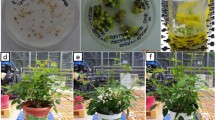Abstract
Flower color was modified in forsythia (Forsythia x intermedia cv ‘Spring Glory’) by inducing anthocyanin synthesis in petals through sequential Agrobacterium-mediated transformation with dihydroflavonol 4-reductase from Antirrhinum majus (AmDFR) and anthocyanidin synthase from Matthiola incana (MiANS) genes. This is the second report of flower color modification of an ornamental shrub after rose, and the first time an ANS gene is used for this purpose. Double transformants (AmDFR+MiANS) displayed a novel bronze-orange petal color, caused by the de novo accumulation of cyanidin-derived anthocyanins over the carotenoid yellow background of wild type (wt), and intense pigmentation of vegetative organs. Transformation with single genes (either AmDFR or MiANS) produced no change in flower color, showing a multistep control of late anthocyanin pathway in petals of forsythia. Analysis of relevant late flavonoid pathway genes – an endogenous flavonoid glycosyltransferase (FiFGT) and transformed DFR and ANS genes – showed appropriate expression in flower organs. Functional characterization of FiFGT expressed in E. coli revealed its ability to metabolize both flavonols and anthocyanidin substrates, a prerequisite for effective anthocyanin accumulation in petals of plants transformed with constructs leading to anthocyanidin synthesis. Biochemical analyses of flavonoid compounds in petals and leaves showed that, besides anthocyanin induction in petals of double transformants, the accumulation pattern of flavan-3-ols was quantitatively and qualitatively modified in petals and leaves of transformants, in agreement with the most recent model proposed for flavan-3-ol synthesis. On the other hand, phenylpropanoid, flavone and flavonol pools were not quantitatively affected, indicating a tight regulation of early flavonoid pathway.
Similar content being viewed by others
References
Boss P.K., Davies C. and Robinson S.P.1996. Expression of anthocyanin biosynthesis pathway genes in red and white grapes.Plant Mol. Biol.32: 565–569.
Cadic A.1988. Les Forsythias d'allure nouvelle.Jardins de France Dec-Jan: 26-28.
Chulia A.J. and Tissut M.1975. Accumulation des flavonols et activité PAL, dans la fleur de Forsythia et la feuille de Maïs, en salle conditionnée.Z. Pflanzenphysiol74: 404–414.
Davies K.M. and Schwinn K.E.1997. Flower colour. In: Geneve R.L., Preece J.E. and Merkle S.A. (eds), Biotechnology of ornamental Plants, pp. 259–294. CAB International, Wallingford.
Ford C.M., Boss P.K. and Høj P.B.1998. Cloning and characterization of Vitis vinifera UDP-glucose:flavonoid 3-O-glucosyltransferase, a homologue of the enzyme encoded by the maize bronze-1 locus that may primarily serve to glycosylate anthocyanidins in vivo.J. Biol. Chem.273: 9224–9233.
Forkmann G. and Heller W.1999. Biosynthesis of flavonoids. In: Sankawa U. (ed.), Comprehensive Natural Products Chemistry, pp. 713–748. Elsevier, Amsterdam.
Forkmann G. and Martens S.2001. Metabolic engineering and applications of flavonoids.Curr Op. Biotechnol.12: 155–160.
Harborne J.B. and Green P.S.1980. A chemotaxonomic survey of flavonoids in leaves of the Oleaceae.Bot. J. Linn. Soc.81: 155–167.
Heller W. and Forkmann G.1993. Biosynthesis of flavonoids. In: Harborne J.B. (ed.), The Flavonoids: Advances in Research Since 1986, pp. 499–535. Chapman & Hall, London.
Holton T.A. and Cornish E.C.1995. Genetic and biochemistry of anthocyanin biosynthesis.Plant Cell.7: 1071–1083.
Li Y., Baldauf S., Lim E.K. and Bowles D.J.2001. Phylogenetic analysis of the UDP-glycosyltransferase multigene family of Arabidopsis thaliana.J. Biol. Chem.276: 4338–4343.
Meyer P., Heidmann I., Forkmann G. and Saedler H.1987. A new Petunia flower color generated by transformation of a mutant with a maize gene.Nature330: 667–678.
Miller K.D., Strommer J. and Taylor L.P.2002. Conservation in divergent solanaceous species of the unique gene structure and enzyme activity of a gametophytically-expressed flavonols 3-O-galactosyltransferase.Plant Mol. Biol.48: 233–242.
Page R.D.M.1996. Treeview: an application to display phylogenetic trees on personal computers.Comp. Appl. Biosci.12: 357–358.
Poupard P., Brunel N., Leduc N., Viémont J.D., Strullu D.G. and Simoneau P.2001. Expression of a Bet v 1 homologue gene encoding a PR-10 protein in birch roots: induction by auxin and localisation of the transcripts by in situ hybridisation.Austr. J. Plant Physiol.28: 57–63.
Rosati C., Cadic A., Renou J.P. and Duron M.1996. Regeneration and Agrobacterium-mediated transformation of Forsythia x intermedia “Spring Glory”.Plant Cell. Rep. 16: 114-117.
Rosati C., Cadic A., Duron M., Renou J.P. and Simoneau P.1997. Molecular cloning and expression analysis of dihydroflavonol 4-reductase gene in flower organs of Forsythia x intermedia.Plant Mol. Biol.35: 303–311.
Rosati C., Cadic A., Duron M., Amiot M.J., Tacchini M., Martens S. and Forkmann G.1998. Flavonoid metabolism in Forsythia flowers.Plant Sci.139: 133–140.
Rosati C., Cadic A., Duron M., Ingouff M. and Simoneau P.1999. Molecular characterization of the anthocyanidin synthase gene in Forsythia x intermedia reveals organ-specific expression during flower development.Plant Sci.149: 73–79.
Treutter D.1989. Chemical reaction detection of catechins and procyanidins with 4-dimethylaminocinnamaldehyde.J. Chromatogr. A.467: 185–193.
Treutter D., Santos-Buelga C., Gutmann M. and Kolodziej H.1994. Identification of flavan-3-ols and procyanidins by HPLC and chemical reaction detection.J. Chromatogr. A667: 290–297.
van der Krol A.R., Lenting P.E., Veenstra J., van der Meer I.M., Gerats A.G.M., Mol J.N.M. and Stuitje A.R.1988. An antisense chalcone synthase gene in transgenic plants inhibits flower pigmentation.Nature333: 866–869.
Vogt T., Grimm R. and Strack D.1999. Cloning and expression of a cDNA encoding betanidin 5-O-glucosyltransferase, a betanidin-and flavonoid-specific enzyme with high homology to inducible glucosyltransferases from the Solanaceae.Plant J.19: 509–519.
Vogt T. and Jones P.2000. Glycosyltransferases in plant natural product synthesis: characterization of a supergene family.Trends Plant Sci.5: 380–386.
Xie D.Y., Sharma S.B., Paiva N.L., Ferreira D. and Dixon R.A.2003. Role of anthocyanidin reductase, encoded by BANYULS in plant flavonoid biosynthesis.Science299: 396–399.
Author information
Authors and Affiliations
Rights and permissions
About this article
Cite this article
Rosati, C., Simoneau, P., Treutter, D. et al. Engineering of flower color in forsythia by expression of two independently-transformed dihydroflavonol 4-reductase and anthocyanidin synthase genes of flavonoid pathway. Molecular Breeding 12, 197–208 (2003). https://doi.org/10.1023/A:1026364618719
Issue Date:
DOI: https://doi.org/10.1023/A:1026364618719




